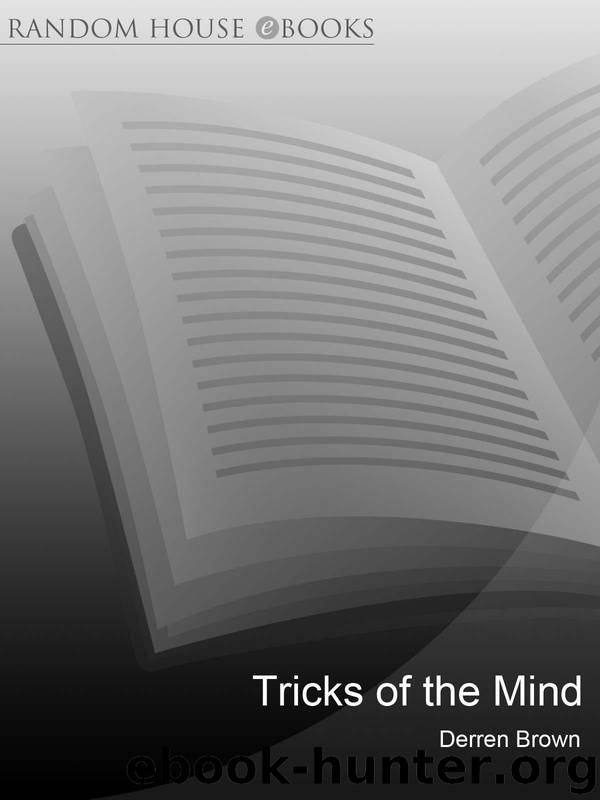Tricks of the Mind by Derren Brown

Author:Derren Brown
Language: eng
Format: mobi
Publisher: Transworld
Published: 2007-10-07T21:00:00+00:00
Playing with Pictures
Do this for me. Think of an experience that makes you feel great, or terrible. Something that annoys or excites you. Do this now. Anything you feel strongly about. Good or bad – but please, nothing traumatic.
When you’ve settled on something, and felt the flutter of response, review what it was you saw in your mind. A short film or mental picture would undoubtedly have appeared, triggering that emotion. One of the more sensible tenets of NLP is that the way you represent this picture or film will affect the way you emotionally respond to it. To test this, try two things: first, enlarge the picture and make it brighter and more colourful. Turn up the sound and turn it into a sharp, high-definition image. Zoom in on it. Changing the picture in this way is very likely to increase your emotional response. Now try the opposite. Make the image smaller, and let the colour run out of it. Make it rather fuzzy and darker. If this is something you were witness to, shift the ‘camera’ to a third-person perspective: see yourself in the picture rather than viewing it out of your own eyes. Pull the black and white picture away from you until it feels far away. Doing this can cause your emotional response to dwindle away almost to nothing at all.
Here you are consciously controlling variables that your mind naturally finds for itself. You really can’t feel strongly about anything unless you represent it vividly to yourself, which normally means large, close-up images seen through the first-person perspective. Equally, it’s hard to get excited about something you think of in a far-off, fuzzy way. Compare what appears in your head when you think of a great time you recently had with a person – pause; do that now and note what comes to mind – with imagining going out and buying some jam with a work colleague who doesn’t particularly interest you (now do that). At a guess, I’d say you saw the first image from your own perspective, right slap in front of you, clear and sharp and detailed. The second image of preserve shopping probably included you in it (i.e., was seen from a third-person perspective), was vague and difficult to pin down, maybe greyer, smaller, somehow further away, somehow not right in front of you like the first one.
By changing those variables – the size, shape, colour, brightness and position of the image – you can play a lot with how you naturally react to the content of it. One very useful idea if, say, you want to feel more motivated about a task is to look at how you picture something that does motivate you, then shift the problem task so it looks and feels the same as the one that naturally gets you all worked up. In fact, if you trick yourself into representing it in exactly the same way, you really can’t not feel that buzz of motivation. It’s a fascinating exercise.
Download
This site does not store any files on its server. We only index and link to content provided by other sites. Please contact the content providers to delete copyright contents if any and email us, we'll remove relevant links or contents immediately.
Call Me by Your Name by André Aciman(20371)
Ready Player One by Cline Ernest(14521)
How to Be a Bawse: A Guide to Conquering Life by Lilly Singh(7384)
Wiseguy by Nicholas Pileggi(5669)
The Kite Runner by Khaled Hosseini(5081)
On Writing A Memoir of the Craft by Stephen King(4863)
Audition by Ryu Murakami(4840)
The Crown by Robert Lacey(4722)
Call me by your name by Andre Aciman(4612)
Gerald's Game by Stephen King(4571)
Harry Potter and the Cursed Child: The Journey by Harry Potter Theatrical Productions(4439)
Dialogue by Robert McKee(4321)
The Perils of Being Moderately Famous by Soha Ali Khan(4169)
Dynamic Alignment Through Imagery by Eric Franklin(4115)
Apollo 8 by Jeffrey Kluger(3635)
Seriously... I'm Kidding by Ellen DeGeneres(3575)
The Inner Game of Tennis by W. Timothy Gallwey(3575)
How to be Champion: My Autobiography by Sarah Millican(3554)
Darker by E L James(3475)
